Synergistic Effects of Epoxidized Soybean Oil and Polyester Fiber on Crumb Rubber Modified Asphalt Using Response Surface Methodology
Abstract
:1. Introduction
2. Materials and Methods
2.1. Materials
2.2. Preparation of Composite Modified Asphalt
2.3. Tests
2.3.1. Rheological Properties of Asphalt
2.3.2. Storage Stability Tests
2.4. Response Surface Methodology
3. Results and Discussion
3.1. Response Surface Methodology
3.1.1. Low-Temperature Rheological Property
3.1.2. High-Temperature Rheological Property
3.1.3. Design Optimization Comparison
3.2. Experimental Analysis of Temperature Scanning
3.3. Storage Stability
3.3.1. Softening Point Difference after Segregation
3.3.2. Fluorescence Microscope Test after Segregation
3.3.3. Scanning Electron Microscopy Analysis
4. Conclusions
- (1)
- Polyester fiber’s stabilizing and reinforcing effects mitigate the negative effect of epoxidized soybean oil’s softening effect on the high-temperature rheological properties of modified asphalt. Epoxidized soybean oil can effectively supplement the light components of crumb rubber asphalt to improve the compatibility between crumb rubber and asphalt. The synergistic effects of the CR, PF, and ESO modifiers improve the high- and low-temperature performances of asphalt.
- (2)
- The optimal relative percentage dosages of crumb rubber, polyester fiber, and epoxidized soybean oil with respect to the matrix asphalt quality are determined to be 22%, 0.34%, and 3.21%, respectively, through the response surface method.
- (3)
- Variance analysis and significance analysis of the RSM show that the p-values of the model are all less than the significance threshold of 0.05, and that the correlation coefficient and the adjusted determination coefficient are close to 1. The fitting degree is high, and the correlation is significant.
- (4)
- The softening point difference of ESO + PF + CR modified asphalt is 46.9% lower than that of ESO + CR and 51.4% lower than CR. Quantification of the fluorescence area reveals that the stability coefficient of ESO + PF + CR is closest to 1. Polyester fibers have good adhesion with crumb rubber and asphalt, and the overlap between fibers forms a three-dimensional network structure, which plays the role of reinforcement and consolidation in asphalt binder. All these indicate that PF and ESO can improve the storage stability of crumb rubber modified asphalt.
Author Contributions
Funding
Institutional Review Board Statement
Informed Consent Statement
Data Availability Statement
Acknowledgments
Conflicts of Interest
References
- Gao, Y.; Xie, Y.; Liao, M.; Li, Y.; Zhu, J.; Tian, W. Study on the Mechanism of the Effect of Graphene on the Rheological Properties of Rubber-Modified Asphalt Based on Size Effect. Constr. Build. Mater. 2023, 364, 129815. [Google Scholar] [CrossRef]
- Sun, D.; Kandare, E.; Maniam, S.; Zhou, A.; Robert, D.; Buddhacosa, N.; Giustozzi, F. Thermal-Based Experimental Method and Kinetic Model for Predicting the Composition of Crumb Rubber Derived from End-of-Life Vehicle Tyres. J. Clean. Prod. 2022, 357, 132002. [Google Scholar] [CrossRef]
- Mohamed, A.S.; Cao, Z.; Xu, X.; Xiao, F.; Abdel-Wahed, T. Bonding, Rheological, and Physiochemical Characteristics of Reclaimed Asphalt Rejuvenated by Crumb Rubber Modified Binder. J. Clean. Prod. 2022, 373, 133896. [Google Scholar] [CrossRef]
- Zhu, Y.; Xu, G.; Ma, T.; Fan, J.; Li, S. Performances of Rubber Asphalt with Middle/High Content of Waste Tire Crumb Rubber. Constr. Build. Mater. 2022, 335, 127488. [Google Scholar] [CrossRef]
- Poovaneshvaran, S.; Mohd Hasan, M.R.; Putra Jaya, R. Impacts of Recycled Crumb Rubber Powder and Natural Rubber Latex on the Modified Asphalt Rheological Behaviour, Bonding, and Resistance to Shear. Constr. Build. Mater. 2020, 234, 117357. [Google Scholar] [CrossRef]
- Nanjegowda, V.H.; Biligiri, K.P. Utilization of High Contents of Recycled Tire Crumb Rubber in Developing a Modified-Asphalt-Rubber Binder for Road Applications. Resour. Conserv. Recycl. 2023, 192, 106909. [Google Scholar] [CrossRef]
- Mousavi, M.; Hosseinnezhad, S.; Kabir, S.F.; Burnett, D.J.; Fini, E.H. Reaction Pathways for Surface Activated Rubber Particles. Resour. Conserv. Recycl. 2019, 149, 292–300. [Google Scholar] [CrossRef]
- Zheng, W.; Wang, H.; Chen, Y.; Ji, J.; You, Z.; Zhang, Y. A Review on Compatibility Between Crumb Rubber and Asphalt Binder. Constr. Build. Mater. 2021, 297, 123820. [Google Scholar] [CrossRef]
- Duan, K.; Wang, C.; Liu, J.; Song, L.; Chen, Q.; Chen, Y. Research Progress and Performance Evaluation of Crumb-Rubber-Modified Asphalts and their Mixtures. Constr. Build. Mater. 2022, 361, 129687. [Google Scholar] [CrossRef]
- Wang, X.; Hong, L.; Wu, H.; Liu, H.; Jia, D. Grafting Waste Rubber Powder and its Application in Asphalt. Constr. Build. Mater. 2021, 271, 121881. [Google Scholar] [CrossRef]
- Liu, Q.; Liu, J.; Yu, B.; Zhang, J.; Pei, J. Evaluation and Optimization of Asphalt Binder and Mixture Modified with High Activated Crumb Rubber Content. Constr. Build. Mater. 2022, 314, 125676. [Google Scholar] [CrossRef]
- Feng, X.; Liang, H.; Dai, Z. Rheological Properties and Microscopic Mechanism of Waste Cooking Oil Activated Waste Crumb Rubber Modified Asphalt. J. Road Eng. 2022, 2, 357–368. [Google Scholar] [CrossRef]
- Kuang, D.; Jiao, Y.; Ye, Z.; Lu, Z.; Chen, H.; Yu, J.; Liu, N. Diffusibility Enhancement of Rejuvenator by Epoxidized Soybean Oil and its Influence on the Performance of Recycled Hot Mix Asphalt Mixtures. Materials 2018, 11, 833. [Google Scholar] [CrossRef]
- Wei, C.; Zhang, H.; Duan, H. Effect of Catalytic-Reactive Rejuvenator on Structure and Properties of Aged Sbs Modified Asphalt Binders. Constr. Build. Mater. 2020, 246, 118531. [Google Scholar] [CrossRef]
- Si, J.; Li, Y.; Wang, J.; Niyigena, A.R.; Yu, X.; Jiang, R. Improving the Compatibility of Cold-Mixed Epoxy Asphalt Based on the Epoxidized Soybean Oil. Constr. Build. Mater. 2020, 243, 118235. [Google Scholar] [CrossRef]
- Li, Q.; Zhang, H.; Chen, Z. Improvement of Short-Term Aging Resistance of Styrene-Butadiene Rubber Modified Asphalt by Sasobit and Epoxidized Soybean Oil. Constr. Build. Mater. 2021, 271, 121870. [Google Scholar] [CrossRef]
- Lei, Y.; Wang, H.; Fini, E.H.; You, Z.; Yang, X.; Gao, J.; Dong, S.; Jiang, G. Evaluation of the Effect of Bio-Oil on the High-Temperature Performance of Rubber Modified Asphalt. Constr. Build. Mater. 2018, 191, 692–701. [Google Scholar] [CrossRef]
- Ma, J.; Hesp, S.A.M. Effect of Recycled Polyethylene Terephthalate (Pet) Fiber on the Fracture Resistance of Asphalt Mixtures. Constr. Build. Mater. 2022, 342, 127944. [Google Scholar] [CrossRef]
- Slebi-Acevedo, C.J.; Lastra-González, P.; Pascual-Muñoz, P.; Castro-Fresno, D. Mechanical Performance of Fibers in Hot Mix Asphalt: A Review. Constr. Build. Mater. 2019, 200, 756–769. [Google Scholar] [CrossRef]
- Zarei, M.; Abdi Kordani, A.; Ghamarimajd, Z.; Khajehzadeh, M.; Khanjari, M.; Zahedi, M. Evaluation of Fracture Resistance of Asphalt Concrete Involving Calcium Lignosulfonate and Polyester Fiber Under Freeze–Thaw Damage. Theor. Appl. Fract. Mech. 2022, 117, 103168. [Google Scholar] [CrossRef]
- Kou, C.; Chen, Z.; Kang, A.; Zhang, M.; Wang, R. Rheological Behaviors of Asphalt Binders Reinforced by Various Fibers. Constr. Build. Mater. 2022, 323, 126626. [Google Scholar] [CrossRef]
- Kim, M.; Kim, S.; Yoo, D.; Shin, H. Enhancing Mechanical Properties of Asphalt Concrete Using Synthetic Fibers. Constr. Build. Mater. 2018, 178, 233–243. [Google Scholar] [CrossRef]
- Sun, Z.; Ma, Y.; Liu, S.; Li, Y.; Qiu, X.; Luo, Z. Evaluation of Engineering Properties of Fiber-Reinforced Usual-Temperature Synthetic Pitch (Usp) Modified Cold Mix Patching Asphalt. Case Stud. Constr. Mater. 2022, 16, e00997. [Google Scholar] [CrossRef]
- Lu, Q.; Xin, C.; Alamri, M.; Alharthai, M. Development of Porous Asphalt Mixture with Bio-Based Epoxy Asphalt. J. Clean. Prod. 2021, 317, 128404. [Google Scholar] [CrossRef]
- Zhou, Y.; Xu, G.; Leng, Z.; Kong, P.; Wang, H.; Yang, J.; Qiu, W.; Xu, Z.; Chen, X. Investigation on Storage Stability and Rheological Properties of Environment-Friendly Devulcanized Rubber Modified Asphalt. Phys. Chem. Earth Parts A/B/C 2023, 129, 103332. [Google Scholar] [CrossRef]
- ASTM D7405-2010a; Standard Test Method for Multiple Stress Creep and Recovery (MSCR) of Asphalt Binder Using a Dynamic Shear Rheometer. ASTM International: West Conshohocken, PA, USA, 2010.
- Shi, K.; Ma, F.; Liu, J.; Song, R.; Fu, Z.; Dai, J.; Li, C.; Wen, Y. Development of a New Rejuvenator for Aged Sbs Modified Asphalt Binder. J. Clean. Prod. 2022, 380, 134986. [Google Scholar] [CrossRef]
- ASTM D6648-08(2016); Standard Test Method for Determining the Flexural Creep Stiffness of Asphalt Binder Using the Bending Beam Rheometer (BBR). ASTM International: West Conshohocken, PA, USA, 2016.
- Ministry of Transport of the People’s Republic of China. Standard Test Methods for Bitumen and Bituminous Mixtures for Highway Engineering (JTG E20-2011); China Communications Press: Beijing, China, 2011. [Google Scholar]
- Zhao, Y.; Chen, M.; Wu, S.; Jiang, Q.; Xu, H.; Zhao, Z.; Lv, Y. Effects of Waterborne Polyurethane on Storage Stability, Rheological Properties, and Vocs Emission of Crumb Rubber Modified Asphalt. J. Clean. Prod. 2022, 340, 130682. [Google Scholar] [CrossRef]
- Ke, Y.; Cao, J.; Xu, S.; Bian, C.; Zhang, C.; Jia, X. Storage Stability and Anti-Aging Performance of Sebs/ Organ-Montmorillonite Modified Asphalt. Constr. Build. Mater. 2022, 341, 127875. [Google Scholar] [CrossRef]
- Mirwald, J.; Hofko, B.; Pipintakos, G.; Blom, J.; Soenen, H. Comparison of Microscopic Techniques to Study the Diversity of the Bitumen Microstructure. Micron 2022, 159, 103294. [Google Scholar] [CrossRef]
- Zhang, Z.; Luo, S.; Wang, J.; Sun, M.; Yan, S.; Wang, Q.; Zhang, Y.; Liu, X.; Lei, X. Optimization of Preparation of Lignite-Based Activated Carbon for High-Performance Supercapacitors with Response Surface Methodology. J. Energy Storage 2022, 56, 105913. [Google Scholar] [CrossRef]
- Reza Omranian, S.; Geluykens, M.; Van Hal, M.; Hasheminejad, N.; Rocha Segundo, I.; Pipintakos, G.; Denys, S.; Tytgat, T.; Fraga Freitas, E.; Carneiro, J.; et al. Assessing the Potential of Application of Titanium Dioxide for Photocatalytic Degradation of Deposited Soot on Asphalt Pavement Surfaces. Constr. Build. Mater. 2022, 350, 128859. [Google Scholar] [CrossRef]
- Zhang, J.; Huang, W.; Zhang, Y.; Lv, Q.; Yan, C. Evaluating Four Typical Fibers Used for Ogfc Mixture Modification Regarding Drainage, Raveling, Rutting and Fatigue Resistance. Constr. Build. Mater. 2020, 253, 119131. [Google Scholar] [CrossRef]
- Xie, Y.C.; Kang, K.; Zheng, C.; Lan, L.; Song, H.; Li, H.L.; Kang, J.; Bai, S.P. Optimised Synthesis of Stainless Steel Fibre-Entrapped Activated Carbon Composites Using Response Surface Methodology. Chem. Phys. Lett. 2023, 815, 140355. [Google Scholar] [CrossRef]
- Zhang, T.; Wu, J.; Hong, R.; Ye, S.; Jin, A. Research on Low-Temperature Performance of Steel Slag/Polyester Fiber Permeable Asphalt Mixture. Constr. Build. Mater. 2022, 334, 127214. [Google Scholar] [CrossRef]
- Padhan, R.K.; Sreeram, A. Enhancement of Storage Stability and Rheological Properties of Polyethylene (Pe) Modified Asphalt Using Cross Linking and Reactive Polymer Based Additives. Constr. Build. Mater. 2018, 188, 772–780. [Google Scholar] [CrossRef]
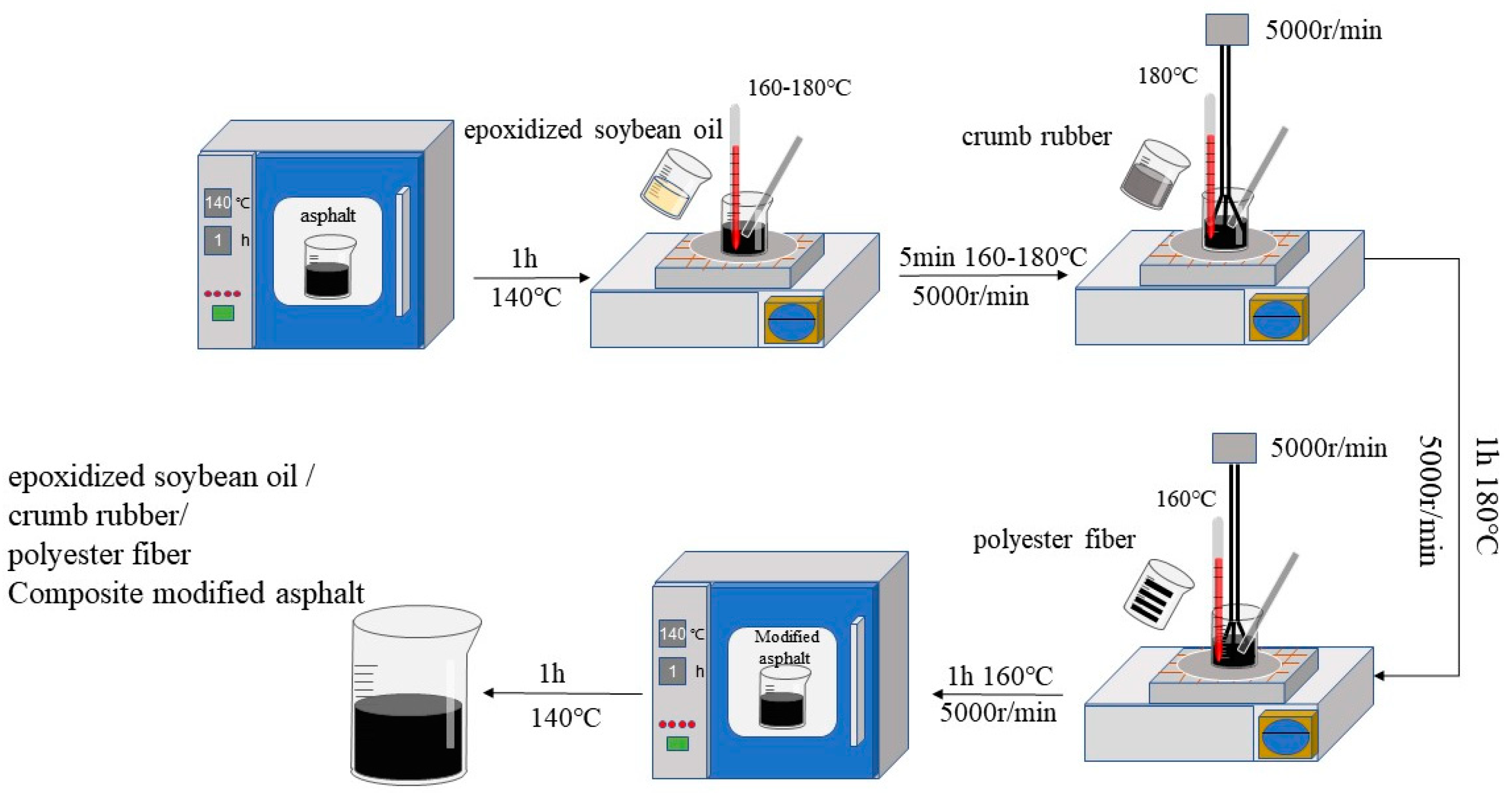
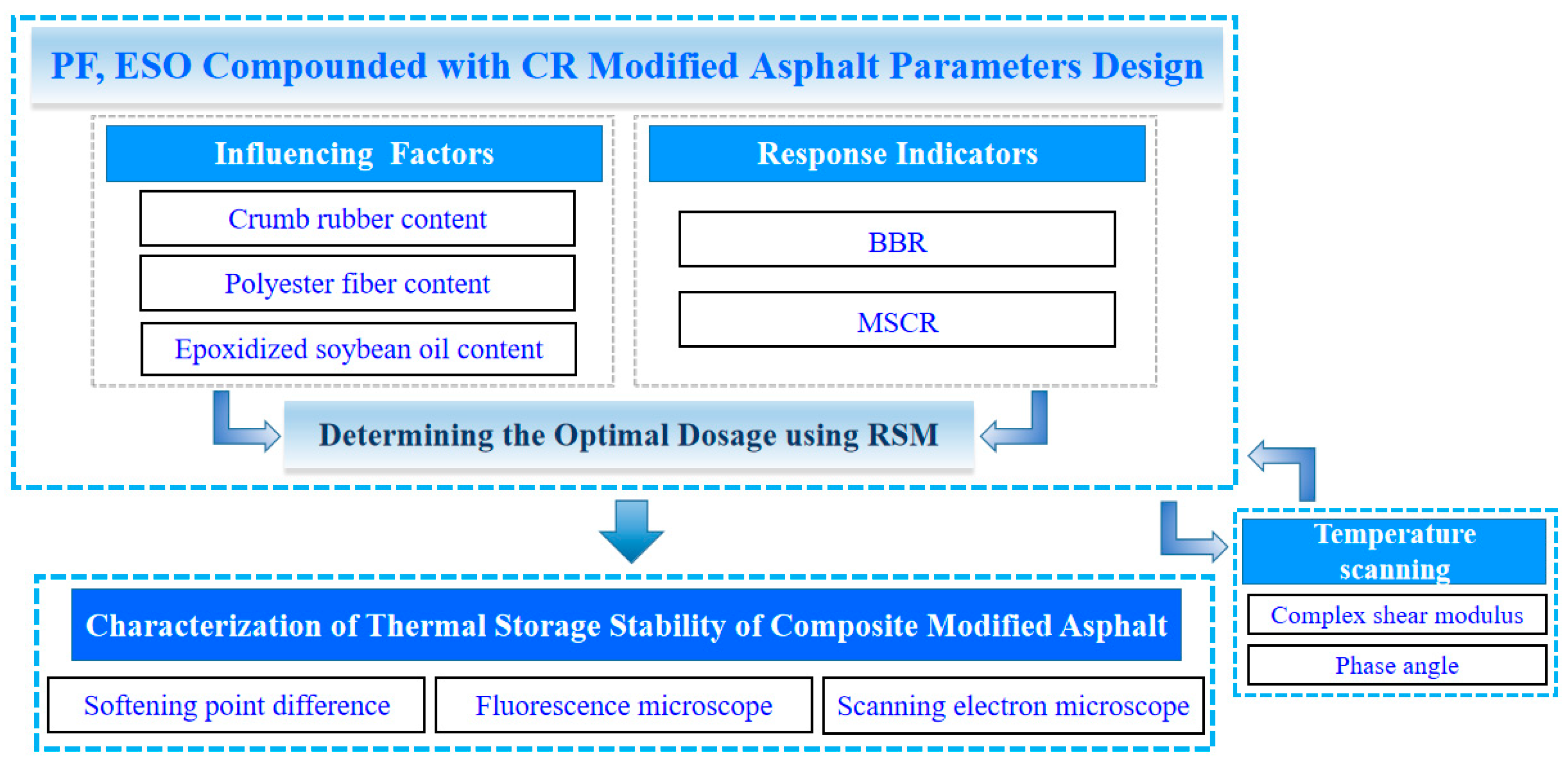

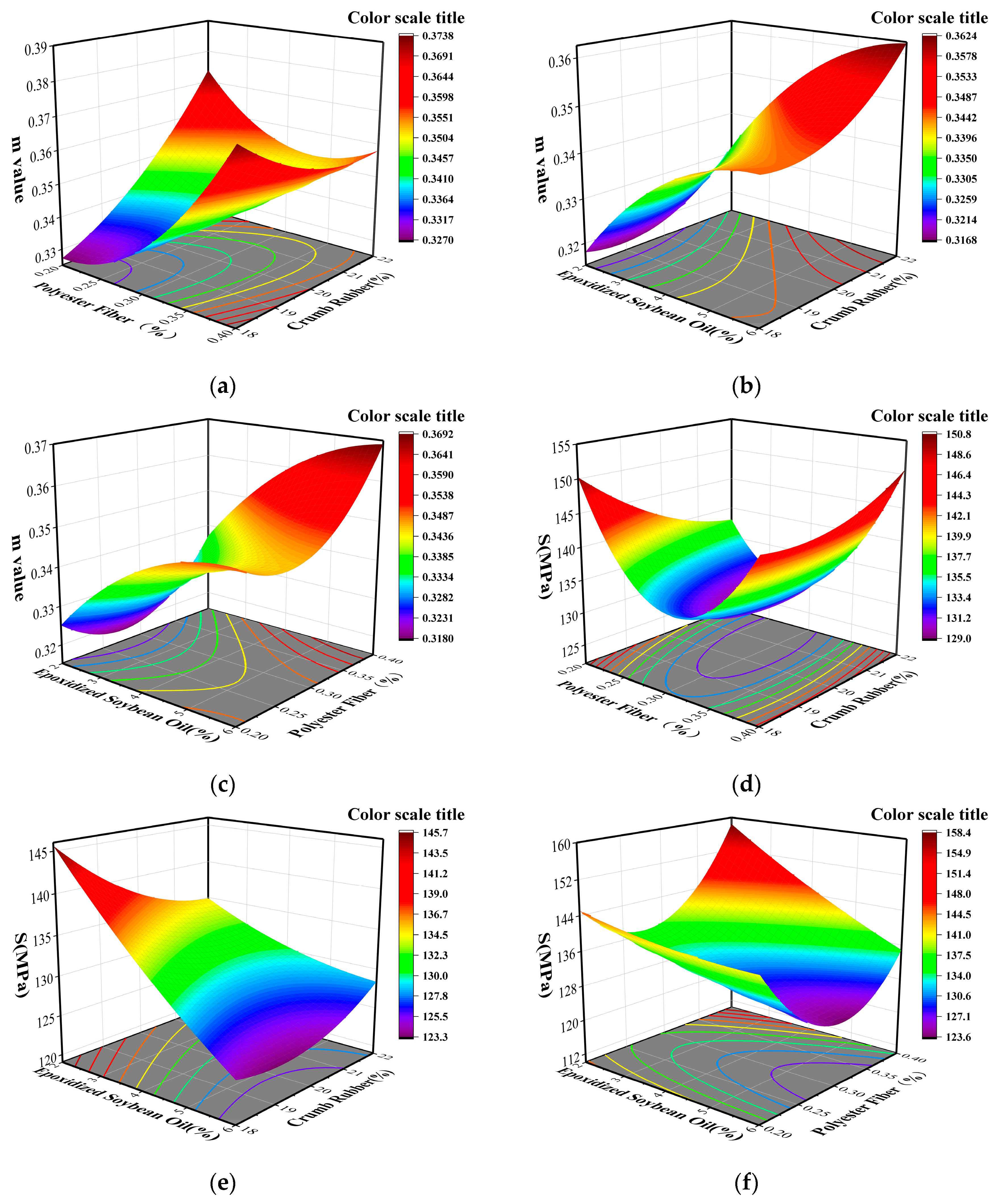
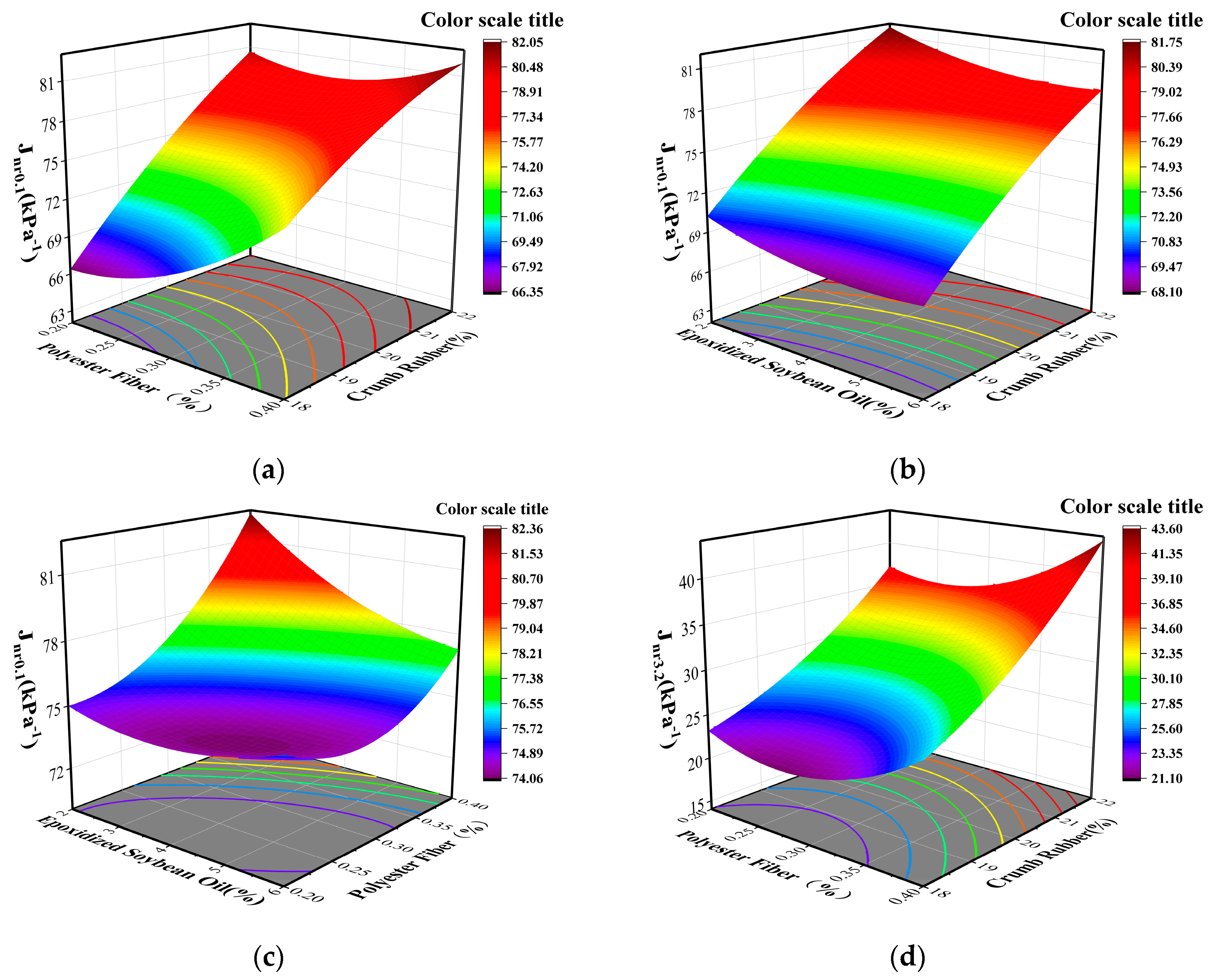

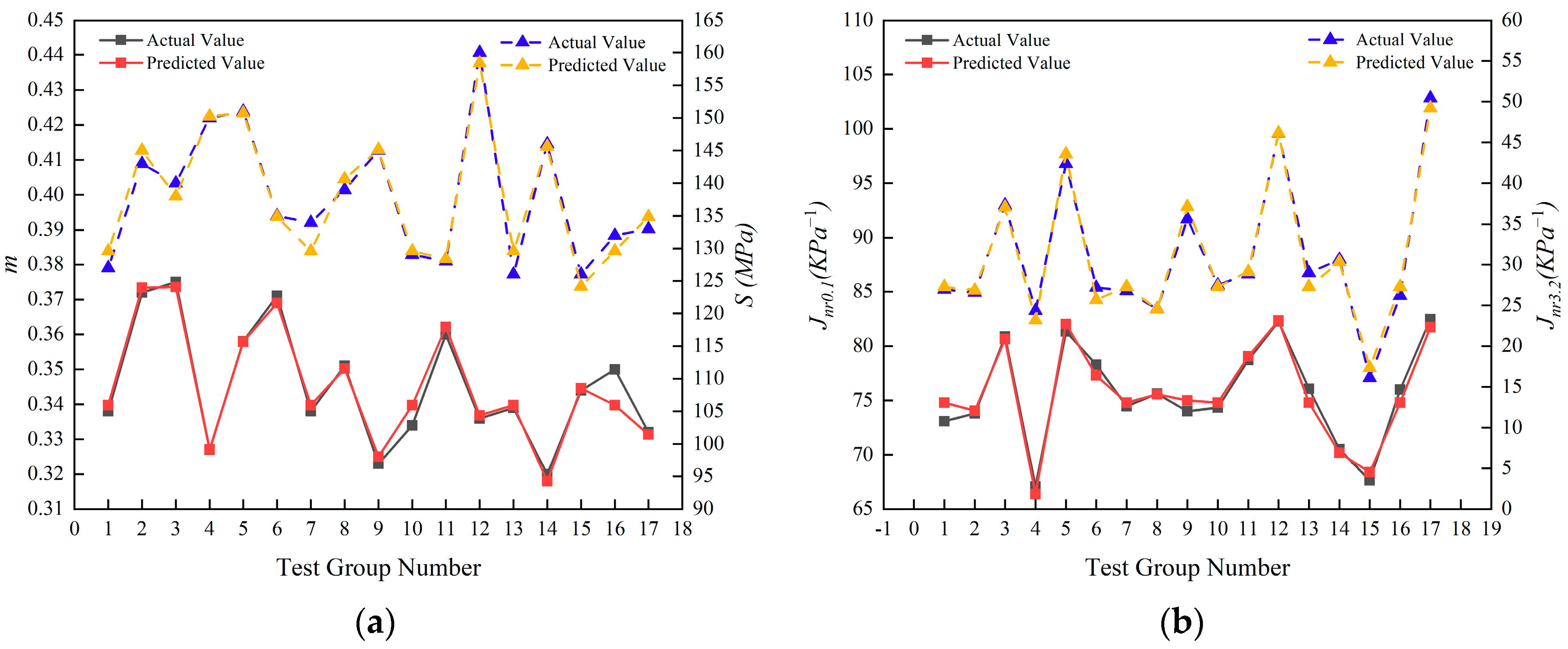



| Material Behavior | Modified Polyesters | ||
|---|---|---|---|
| Diameter (μm) | 20 ± 5 | Extension at break (%) | 30 ± 9 |
| Length (mm) | 6 | Density (g·cm−3) | 1.36 |
| Acid–alkali resistance | Strong | Melting point (°C) | 258 |
| Tensile strength (Mpa) | ≥700 | Ignition point (°C) | 556 |
| Testing Item | Enterprise Standard E-10 | Test Value |
|---|---|---|
| Appearance | Light yellow transparent liquid | Coincidence |
| Tincture (Platinum–cobalt colorimetric) | ≤170 | 130 |
| Epoxidized value (Hydrochloric acid–acetone)% | ≥6.0 | 6.27 |
| Acid value (mg KOH·g−1) | ≤0.5 | 0.4 |
| Iodine number (gI2·(100 g)−1) | ≤5.0 | 2.03 |
| Density (20 °C) | 0.993 ± 0.005 | 0.992 |
| Heating loss (125 °C × 2 h) | ≤0.2 | 0.05 |
| Thermal stability (177 °C × 3 h) | ≥5.7 | 6.20 |
| Flash point (Opening cup) | ≥280 | 306 |
| Index | Technical Requirement | Test Value |
|---|---|---|
| Penetration (25 °C, 100 g, 5 s), 0.1 mm | 60~80 | 71 |
| Penetration index (PI) | −1.5~+1.0 | −1.16 |
| Softening point, °C | ≥46 | 47.1 |
| Ductility (10 °C, 5 cm·min−1), cm | ≥15 | 76.3 |
| Dynamic viscosity (60 °C), Pas | ≥180 | 197 |
| Flash point (COC), °C | ≥260 | 314 |
| Solubility, % | ≥99.5 | 99.89 |
| Wax content, % | ≤2.2 | 1.5 |
| Density (15 °C), g·cm−3 | — | 1.026 |
| Test Group Number | Epoxidized Soybean Oil | Crumb Rubber | Polyester Fiber |
|---|---|---|---|
| 1 | 4% | 18% | 0.2% |
| 2 | 4% | 22% | 0.2% |
| 3 | 4% | 18% | 0.4% |
| 4 | 4% | 22% | 0.4% |
| 5 | 2% | 18% | 0.3% |
| 6 | 2% | 22% | 0.3% |
| 7 | 6% | 18% | 0.3% |
| 8 | 6% | 22% | 0.3% |
| 9 | 2% | 20% | 0.2% |
| 10 | 2% | 20% | 0.4% |
| 11 | 6% | 20% | 0.2% |
| 12 | 6% | 20% | 0.4% |
| 13 | 4% | 20% | 0.3% |
| 14 | 4% | 20% | 0.3% |
| 15 | 4% | 20% | 0.3% |
| 16 | 4% | 20% | 0.3% |
| 17 | 4% | 20% | 0.3% |
| Index | m | S | Jnr0.1 | Jnr3.2 |
|---|---|---|---|---|
| R2 | 0.9643 | 0.9592 | 0.9695 | 0.9875 |
| Adj.R2 | 0.9185 | 0.9067 | 0.9303 | 0.9715 |
| F-value | 21.03 | 18.28 | 24.71 | 61.53 |
| p-value | 0.0003 | 0.0005 | 0.0002 | <0.0001 |
| Lack-of-Fit p-value | 0.8851 | 0.6421 | 0.5066 | 0.1464 |
| Std. Dev. | 0.0049 | 3.07 | 1.23 | 1.47 |
| C.V.% | 1.42 | 2.23 | 1.63 | 4.76 |
| Asphalt Type | Upper Sections | Lower Sections | Differentials |
|---|---|---|---|
| CR | 54.5 | 52.45 | 1.75 |
| ESO + CR | 50.95 | 49.35 | 1.6 |
| ESO + PF + CR | 54.7 | 53.85 | 0.85 |
| Species | ESO + PF + CR | ESO + CR | CR |
|---|---|---|---|
| Upper sections (St) | 185.361 | 401.814 | 729.18 |
| Lower sections (Sb) | 234.442 | 1118.366 | 2954.095 |
| Coefficient of stability (Ise) | 0.79 | 0.36 | 0.25 |
Disclaimer/Publisher’s Note: The statements, opinions and data contained in all publications are solely those of the individual author(s) and contributor(s) and not of MDPI and/or the editor(s). MDPI and/or the editor(s) disclaim responsibility for any injury to people or property resulting from any ideas, methods, instructions or products referred to in the content. |
© 2023 by the authors. Licensee MDPI, Basel, Switzerland. This article is an open access article distributed under the terms and conditions of the Creative Commons Attribution (CC BY) license (https://creativecommons.org/licenses/by/4.0/).
Share and Cite
Pan, J.; Jin, J.; Liu, S.; Xiao, M.; Qian, G.; Wang, Z. Synergistic Effects of Epoxidized Soybean Oil and Polyester Fiber on Crumb Rubber Modified Asphalt Using Response Surface Methodology. Materials 2023, 16, 3469. https://doi.org/10.3390/ma16093469
Pan J, Jin J, Liu S, Xiao M, Qian G, Wang Z. Synergistic Effects of Epoxidized Soybean Oil and Polyester Fiber on Crumb Rubber Modified Asphalt Using Response Surface Methodology. Materials. 2023; 16(9):3469. https://doi.org/10.3390/ma16093469
Chicago/Turabian StylePan, Jie, Jiao Jin, Shuai Liu, Mengcheng Xiao, Guoping Qian, and Zhuo Wang. 2023. "Synergistic Effects of Epoxidized Soybean Oil and Polyester Fiber on Crumb Rubber Modified Asphalt Using Response Surface Methodology" Materials 16, no. 9: 3469. https://doi.org/10.3390/ma16093469
APA StylePan, J., Jin, J., Liu, S., Xiao, M., Qian, G., & Wang, Z. (2023). Synergistic Effects of Epoxidized Soybean Oil and Polyester Fiber on Crumb Rubber Modified Asphalt Using Response Surface Methodology. Materials, 16(9), 3469. https://doi.org/10.3390/ma16093469







